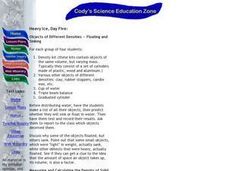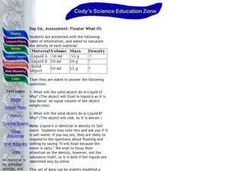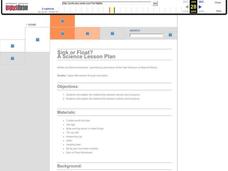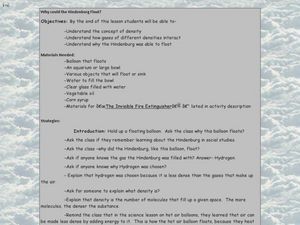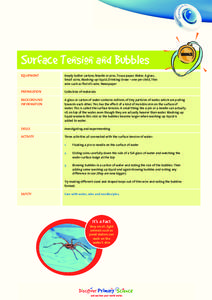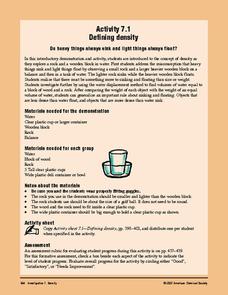Curated OER
Density
Second graders watch a demonstration and complete an experiment to determine how an objects' density allows it to float or sink. They work in small groups to assimilate the characteristics of items that float as opposed to simply...
Curated OER
Buoyancy
In this buoyancy worksheet, learners use clay, water, newspaper, and more to create buoyant objects. Students follow 5 directions, and answer 4 questions.
Curated OER
Learning About Matter And Energy
Students learn about matter and energy. In this science lesson plan, students gain an understanding of the properties of matter and energy as they discover that some things float, some things dissolve in water and discuss that energy can...
Curated OER
Heavy Ice: Day Five
Learners explore physics by conducting a class experiment. In this density lesson plan, students examine a list of items and discuss whether they will sink or float and then determine their density. Learners examine the objects over five...
Curated OER
Density and Buoyancy Experimental Design
Students must plan, design, and conduct an experiment that answers the scientific question: "Come up with a question that addresses the factors (variables) of the water and its effect on whether an object floats or sinks."
Curated OER
Interactive Writing
First graders write about vehicles that float using the interactive writing procedure.
Curated OER
Day Six: Floater What Ifs
Young scholars observe earth science by examining results from an experiment. In this buoyancy lesson, students practice floating different items in two different liquids and identify why certain objects will float and others sink. Young...
Curated OER
Sink or Float?
Students analyze the relationship between density, buoyancy, and salinity. In this chemical properties lesson plan, students read a background activity for the lesson plan and experiments to the topics. Students discuss the questions and...
Curated OER
Why Could the Hindenburg Float?
Tenth graders experiment with floating and sinking objects and heavy and light liquids, using correct terms, like density, to explain what happens. In this Hindenburg lesson, 10th graders watch a demonstration called the invisible...
Curated OER
How Does the USS Alabama Float?
Students investigate buoyancy. In this buoyancy lesson, students apply the Archimedes Principle of Buoyancy to the experiment conducted in class to determine how battleships float.
Curated OER
Condiment Diver: The World's Simplest Cartesian Diver
Young scholars examine buoyancy. In this density lesson students form a hypothesis, collect data and draw a conclusion using the data.
Curated OER
Concrete Canoes
Students explore and analyze the relationship of buoyancy and displacement needed to make an object float. They examine various boat designs, then design and build clay and aluminum boats that hold a cargo of marbles.
Curated OER
Save the Bay
Students explore the concept of environmental stewardship. In this science lesson, students examine the environmental effects of oil spills as they replicate a contained oil spill and clean up.
Curated OER
Surface Tension and Bubbles
Students investigate surface tension and bubbles. In this scientific inquiry lesson plan, students explore how the surface tension of water is able to support tiny objects that actually weigh more than the water as they collect date by...
Curated OER
Water Properties of the Great Salt Lake
Fourth graders examine the ecosystem of the Great Salt Lake in this two-part lesson, completing a KWL chart before and after the field trip to the site. While there, they draw and write about their observations. To test for buoyancy,...
Curated OER
Creating the Ideal Cargo Boat
Students build boats out of clay to test the buoyancy of the boat in water. Students break into pairs and construct their boat to specific guide lines, then experiment with their boat in the water.
Curated OER
Density Challenge
Students calculate the densities of several liquids that appear similar. In this physical science lesson, students go beyond understanding the way liquids of different densities behave to researching how this knowledge applies in...
Curated OER
Build Your Own Submarine
Students construct their own submarine following a certain procedure. In this physics lesson, students calculate the density of objects using a mathematical formula. They explain why some object floats in water while some do not.
American Chemical Society
Defining Density
Three simple activities kick off a unit investigation of density. Your physical scientists make observations on the volume and mass of wood, water, and rocks, and make comparisons. Though this is written for grades three through eight,...
Curated OER
Float the Boat
Students collect data and analyze it using a graph. In this algebra lesson, students identify different bodies of water and relate the flowing to math. They collect data on the rate of flow and the height of flow. They analyze the data...
Curated OER
Density: Floating, Sinking, and Suspending
Students observe teacher demonstrations that illustrate density. For this density lesson, the teacher demonstrates how air bubbles in a carbonated drink can cause a raisin to float and how an egg sinks in fresh water, but floats in salt...
Curated OER
Exploring the Properties of Matter in the Preschool
Students study the properties of the physical and natural world. In this properties of the physical and natural world lesson, preschool students work at discovery tables to see how simple machines work, what happens when items are put...
Curated OER
Liquids in Bottles
Young scholars investigate different liquids to develop their concept of a liquid. They work at a center to tip, swirl, shake, roll, and otherwise investigate seven liquids in small, clear plastic bottles: plain water, corn syrup, liquid...
Curated OER
Float Your Boat
Learners investigate buoyancy, displacement and density. In this flotation lesson students study the Archimedes' Principle, analyze data and draw conclusions.



